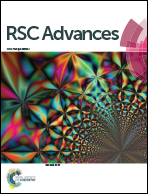Detailed exploration of structure formation of an epoxy-based monolith with three-dimensional bicontinuous structure
Abstract
To explore a clear formation mechanism of a three-dimensional (3D) bicontinuous skeleton and control the structure of an epoxy-based monolith, we have prepared the monolith using a mixture of good and poor solvents. The influences of reaction and phase separation parameters, such as molecular weights and content of porogenic poor solvents, porogenic good solvent concentration, equivalent ratio of epoxy group to amine and reaction temperature on the final morphology are systematically studied by monitoring the reaction process with differential scanning calorimetry (DSC) and observing the cloud points (CP). Depending on the above parameters, the resultant morphology can be varied ranging from closed pore structure to globules aggregated structure, which was controlled by the competitive kinetics between the domain coarsening and the structure freezing. The optimized monoliths with uniform and controllable pores have great potential for application in chromatographic separation, membrane filters, and membrane emulsification.


 Please wait while we load your content...
Please wait while we load your content...